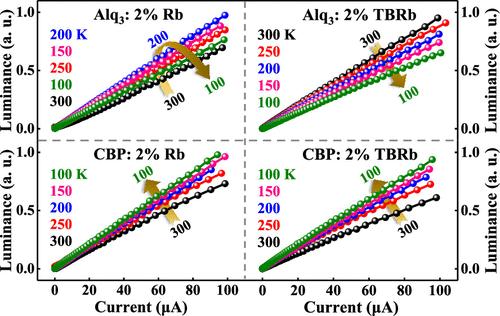Unusual Optical, Electric, and Magnetic Behaviors of OLEDs due to Exothermic/Endothermic Dexter-Energy-Transfer and Fusion Channels of Hot/Cold Triplet Excitons
IF 6.5
1区 物理与天体物理
Q1 MATERIALS SCIENCE, MULTIDISCIPLINARY
引用次数: 0
Abstract
Hot-exciton-based organic light-emitting diodes (HE-OLEDs) have aroused more attention due to their advantages of low cost, high efficiency, and negligible efficiency roll-off. However, their physical behaviors need further investigation because of the evolution diversity of excited states existing in HE-OLEDs. Herein, we employ the two frequently used hosts tris(8-hydroxyquinoline)aluminum (Alq3) and 4,4′-N,N′-dicarbazolebiphenyl (CBP) and the hot-exciton emissive guests rubrene (Rb) and its derivative 2,8-di-tert-butyl-5,11-bis(4-tert-butylphenyl)-6,12-diphenyltetracene (TBRb) to make four HE-OLEDs and use well-known fingerprint magneto-electroluminescence (MEL) curves to probe their microscopic dynamic processes. Interestingly, we find abundant optical, electric, and magnetic behaviors of HE-OLEDs due to exothermic and endothermic Dexter-energy-transfer (DET) and triplet fusion (TF) channels of hot/cold excitons. Specifically, for the case of different bias currents at room temperature, both the low-field MEL curves of Rb- and TBRb-doped Alq3-based OLEDs show a normal intersystem crossing (ISC) of polaron pairs, but those of Rb- and TBRb-doped CBP-based OLEDs present a conversion from a high-level reverse ISC (HL-RISC, S1 ← T2) to an ISC and a normal HL-RISC, respectively, which weakens with an elevated bias current. Moreover, both the high-field MEL curves of Rb- and TBRb-doped Alq3-based (CBP-based) OLEDs show a normal T1F (T2F) of cold (hot) triplet excitons, which strengthens with elevated bias currents. For the case of constant bias currents at variable temperatures, both the low-field MEL curves of Rb- and TBRb-doped Alq3-based OLEDs show an abnormal ISC, which rises with a reducing temperature, but those of Rb- and TBRb-doped CBP-based OLEDs depict a conversion from an ISC to a HL-RISC and a normal HL-RISC, respectively, which intensifies with a decreasing temperature. In addition, the high-field MEL curves of Rb- and TBRb-doped Alq3-based OLEDs separately show a normal and an abnormal T1F, but those of both of Rb- and TBRb-doped CBP-based OLEDs exhibit a normal T2F, which strengthens with a reducing temperature. Furthermore, the quantum efficiency of Rb- and TBRb-doped Alq3-based OLEDs separately show nonmonotonically and monotonically decreased tendencies, but both Rb- and TBRb-doped CBP-based OLEDs show monotonically increased tendencies with a decreasing temperature. Surprisingly, all of the above enriched physical behaviors can be reasonably interpreted within the frames of excited state dynamics that DET from host cold T1,Alq3 (T1,CBP) to guest hot T2 is an endothermic (exothermic) process and T1F in Rb (TBRb) is an exothermic (endothermic) process, but T2F in both Rb and TBRb is exothermic.

热/冷三重激子的放热/退热德克斯特能量转移和聚变通道导致 OLED 出现异常的光学、电学和磁学行为
基于热激子的有机发光二极管(HE-OLED)因其成本低、效率高、效率滚降可忽略不计等优点而受到越来越多的关注。然而,由于 HE-OLED 中激发态的演化多样性,它们的物理行为还需要进一步研究。在这里,我们采用了两种常用的宿主--三(8-羟基喹啉)铝(Alq3)和 4,4′-N,N′-二咔唑联苯(CBP),以及热激发子发射客体--芘(Rb)及其衍生物 2、8-二叔丁基-5,11-双(4-叔丁基苯基)-6,12-二苯基四蒽 (TBRb) 制成了四种 HE-OLED 并使用著名的指纹磁致发光 (MEL) 曲线来探测它们的微观动态过程。有趣的是,我们发现 HE-OLED 具有丰富的光学、电学和磁学行为,这是由于热/冷激子的放热和内热德克斯特能量转移(DET)和三重融合(TF)通道造成的。具体来说,在室温下不同偏置电流的情况下,掺镱和掺镱Alq3基有机发光二极管的低场MEL曲线都显示出极子对的正常系间交叉(ISC),但掺镱和掺镱CBP基有机发光二极管的低场MEL曲线则分别显示出高水平反向ISC(HL-RISC,S1 ← T2)向ISC和正常HL-RISC的转换,这种转换随着偏置电流的升高而减弱。此外,基于 Rb 和 TBRb 掺杂 Alq3(基于 CBP)的有机发光二极管的高场 MEL 曲线都显示出冷(热)三重激子的正常 T1F(T2F),随着偏置电流的升高而增强。在温度变化的恒定偏置电流情况下,掺镱和掺镱的 Alq3 基有机发光二极管的低场 MEL 曲线都显示出异常的 ISC,随着温度降低而上升,但掺镱和掺镱的 CBP 基有机发光二极管的低场 MEL 曲线则分别显示出从 ISC 到 HL-RISC 和正常 HL-RISC 的转换,随着温度降低而增强。此外,掺镱和掺镱的基于 Alq3 的有机发光二极管的高场 MEL 曲线分别显示出正常和异常的 T1F,但掺镱和掺镱的基于 CBP 的有机发光二极管的高场 MEL 曲线均显示出正常的 T2F,且随着温度的降低而增强。此外,掺镱和掺镱的基于 Alq3 的有机发光二极管的量子效率分别呈现出非单调和单调降低的趋势,但掺镱和掺镱的基于 CBP 的有机发光二极管都呈现出随温度降低而单调升高的趋势。令人惊讶的是,上述所有丰富的物理行为都可以在激发态动力学框架内得到合理解释,即从主冷 T1、Alq3(T1、CBP)到客热 T2 的 DET 是一个内热(放热)过程,而 Rb(TBRb)中的 T1F 是一个放热(内热)过程,但 Rb 和 TBRb 中的 T2F 都是放热过程。
本文章由计算机程序翻译,如有差异,请以英文原文为准。
求助全文
约1分钟内获得全文
求助全文
来源期刊

ACS Photonics
NANOSCIENCE & NANOTECHNOLOGY-MATERIALS SCIENCE, MULTIDISCIPLINARY
CiteScore
11.90
自引率
5.70%
发文量
438
审稿时长
2.3 months
期刊介绍:
Published as soon as accepted and summarized in monthly issues, ACS Photonics will publish Research Articles, Letters, Perspectives, and Reviews, to encompass the full scope of published research in this field.
 求助内容:
求助内容: 应助结果提醒方式:
应助结果提醒方式:


